Drill bits are relatively inexpensive, compared to other BHA components, but their performance has a significant impact on overall well costs. Today’s difficult economic environment, combined with ever-increasing wellbore complexities, has driven drill bit manufacturers to strive to improve drilling efficiency and bit performance. In most applications, useful life and ROP are the two key barometers that define the economic benefit that an operator will obtain from a PDC or roller cone bit. From an economic perspective, bit longevity determines the number of trips required to change out tools, while ROP affects the number of rig-hours required to TD the well. Together, these two fundamental factors directly impact overall well costs.
Although advances in tungsten carbide and PDC cutter quality continue at a steady pace, modeling and computer-aided design systems have become increasingly important. Specialized evaluation software can quantify formation properties with data obtained from open-hole logs. These values can then be input into software-based modeling systems to customize a PDC or roller cone bit, for a particular wellbore trajectory and formation types. With low commodity prices and continuing oversupply the new norms, bit providers are revaluating their hardware and application tools, exploring for new ways to further reduce drilling costs.
DIRECT OPERATOR INPUT SPEEDS OPTIMIZATION
Halliburton’s drill bit business-line focuses on process improvement to increase drilling efficiency and address the economic challenges associated with today’s low commodity prices. Halliburton’s Design at the Customer Interface (DatCI) has streamlined product development by incorporating first-hand operator knowledge into the bit design function, to rapidly solve localized application challenges.
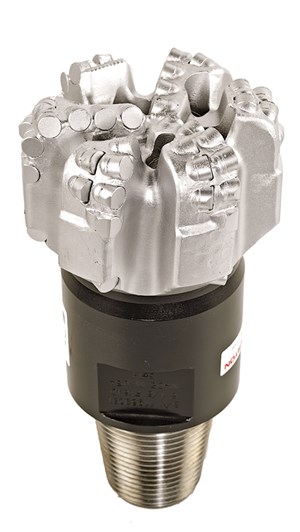
The DatCI design process starts by incorporating direct input from the operator to guide development. The company’s engineers draw from an extensive assortment of analytical tools that include simulation, analysis and design software to select the best bit to achieve performance improvement. Next, a local design team with in-depth knowledge of the application is deployed to the field to guide the process. This rapid-response system quickly addresses the application challenges to maximize drilling efficiency and deliver immediate cost-savings.
The DatCI process was deployed in Oklahoma to increase ROP, while drilling a curved section through the challenging Mississippi Limestone formation. Working with the operator’s drilling engineers, the company selected a MegaForce Series MMD64C PDC bit with SelectCutters, Fig. 1, which drilled 481 ft, at an average ROP of 43.7 ft/hr. The bit run reduced interval drilling hours by 30%, while delivering 51% faster ROP, compared to offset bit performances.
The DatCI process also can be used to optimize roller cone bit performance. In a geothermal application in Indonesia, performance and longevity challenges were causing early bearing failures in 12¼-in. TCI bits due to high temperatures. Engineers worked through the DatCI process, and new optimized pressure contact seals were designed and deployed that are better suited for the environment. The results led to enhanced bit reliability.
BIT BODY DESIGN IMPROVES PERFORMANCE
Tektonic drill bits from National Oilwell Varco (NOV) feature advanced bit body geometry, designed to overcome specific challenges drilling horizontal, vertical and directional hole sections in shale, carbonates and hard rock applications, Fig 2. The NOV R&D team created Tektonic bits after examining rock failure and chip generation, to increase their understanding of bit design and cuttings evacuation. Extensive laboratory and field testing ensures that each Tektonic PDC bit is equipped with options that minimize abrasive wear, and reduce thermal and impact damage. Forward rake blade geometry allows blade height and width optimization, while improving cuttings evacuation. The bits are equipped with Reflektor polished cutters to reduce friction and cutter temperatures, thus improving ROP and minimizing NPT. Full-face exposure of the diamond table from the blade front allows for flow to penetrate above the cutter face, and prevents shale ribbons from adhering to the front of the blade. This feature improves drilling efficiency and mitigates bit balling.
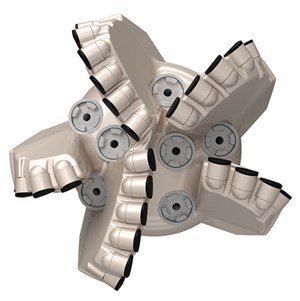
Optimized spiraled blades reduce localized confinement pressures at the cutter rock interaction. An incremented, cut profile along the blade creates a more efficient path for cuttings removal and reduces the amount of energy required to fail rock. The incremented, cut profile minimizes localized confinement on the rock induced by adjacent cutters, and creates a path for efficient cuttings evacuation.
Using upgraded software that enhances real-time drilling simulation, regional design engineers can now gain a better understanding of downhole conditions and efficiently select features specifically tailored for different applications. Dynamic rotational bit modeling simulates the eccentric motion and changing forces experienced during real-life drilling, to more closely match downhole conditions that are not covered by conventional concentric modeling. Advanced fluid flow modeling quantifies and improves hydraulic cleaning and cooling performance. These techniques include detailed examination of cutter face, fluid shear stress, and new techniques for cross-flow mitigation and, examination of cuttings volume.
In the Williston basin, an operator ran a 6-in. Tektonic bit on a motor BHA to drill the lateral section from intermediate casing to TD. The bit drilled the lateral section with a single BHA, making 9,446 ft of hole at an average ROP of 145 ft/hr. The performance increased average ROP by 39%. This run set an operator record for the fastest lateral section, and was the highest average ROP for any run in the area by more than 1,000 ft.
ROLLING CUTTERS RESIST ABRASIVE WEAR
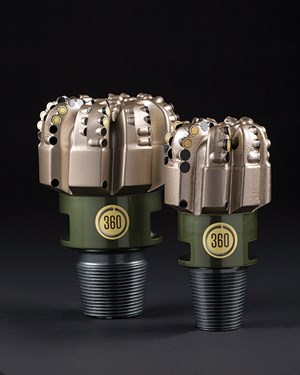
Smith Bits, a Schlumberger company, produces ONYX 360 rolling PDC cutters that enable the entire circumference of the diamond edge to be used to drill a formation. The rolling cutters are positioned strategically in the high-wear shoulder area of the cutting structure, Fig. 3. Due to their rolling action, the cutters stay sharp for a longer period of time. The company introduced a new, 16-mm rolling cutter that offers a wide range of applications, including North American laterals, and challenging interbedded formations in onshore and offshore environments.
In western Oklahoma, a 6⅛-in., seven-bladed PDC bit, configured with new 16-mm rolling cutters, was used to drill horizontal intervals through an abrasive sandstone formation. Over the course of six consecutive wells, the PDC bit with 16-mm rolling cutters increased footage drilled by 100%, with an average 40% increase in ROP.
In an onshore Louisiana well, a six-bladed PDC bit with 16-mm rolling cutters consistently delivered an additional 1,500 ft per run in the upper portion of the hole interval. By extending the run length into a deeper part of the well, the new bit enabled the operator to complete the entire interval in only two bit runs, compared to four bit runs required in offset wells.
CONICAL DIAMOND ELEMENT INCREASES BIT DURABILITY
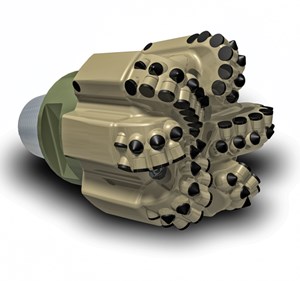
StingBlade PDC bits use strategically placed Stinger conical diamond elements across the bit face to enhance the durability of the cutting structure and improve overall drilling efficiency, Fig. 4. The conical diamond element has an ultra-thick diamond layer designed to improve wear and impact resistance, compared with conventional PDC cutters. The conical shape of the element induces high point-loading on formations, which improves ROP in hard-rock drilling applications by introducing a plowing mechanism, as opposed to the shearing action of a conventional PDC bit.
The bits have been used in more than 1,400 wells in 39 countries. Applications range from onshore/offshore environments and unconventional plays in North and South America, to hard carbonate drilling in Russia and the Middle East. To date, more than 5.6 MMft have been drilled using this technology.
In a pre-salt cluster offshore Brazil, an operator used a StingBlade bit to drill the 12¼-in., pre-salt reservoir consisting of hard carbonates with hard silicate nodules, with UCS in excess of 50,000 psi. Using the new bit, the operator was able to drill the entire interval in a single run, saving the cost of an additional bit trip and outperforming offset runs to the extent of 25% greater footage and 11% better ROP.
CUTTER CONFIGURATION IMPROVES STABILITY
To gain access to difficult-to-reach reservoirs, operators consistently design and drill more complex wellbore geometries and longer laterals. To deliver the required borehole trajectories and lengths, the use of rotary steerable systems (RSS) is becoming more common. However, most all RSS systems will fail, if they are subjected to high vibration levels, forcing the operator to trip for tool change-out. Additionally, during drilling operations, rig personnel monitor vibrations and will reduce parameters, as necessary, to stabilize the BHA. If vibrations reach a critical point, drilling stops, and the BHA is picked up, off bottom, to terminate drillstring harmonics. These different dysfunctions force drillers to use lower operating parameters than what are necessary to maximize ROP.
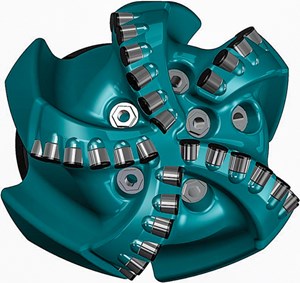
As a solution, Ulterra designed CounterForce PDC bits with a unique cutter configuration that reduces reactive torque, improving drilling efficiency, Fig. 5. The cutters are aligned with alternating side rakes, enabling them to work together to smooth the rock shearing action by countering lateral vibration. The result is increased dynamic stability and improved tool-face control.
In South Texas, a major operator applied CounterForce PDC bits on a Weatherford RSS to solve its vibration problems. On one well, the BHA drilled out from under the surface casing, then through the curve and lateral, to TD the well in one run. Comparing the CounterForce U516M to other types of PDC bits used in the area, the U516M, on average, drilled 10% faster and was tripped 32% fewer times for tool failures. With 41 runs in 2015, the U516M has been the performance leader for this operator in this application.
CounterForce performance also has been validated using an electronic drilling recorder to measure vibration levels. On a four-well pad in South Texas, a CounterForce U516M was run on an RSS BHA on three wells, and another bit type on the fourth. The stick-slip magnitude was 35% lower, on average, for the three CounterForce runs, compared to the offset. Average ROP for the three CounterForce runs was 27% faster than on the offset, saving the operator 13 hr on each of the three wells.
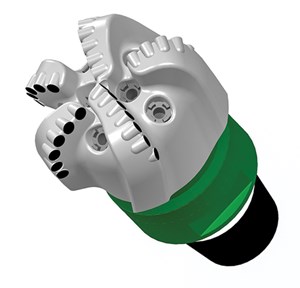
In the eastern Gulf of Mexico, a major operator wanted to reduce vibration levels while drilling a 16½-in. hole section through difficult Miocene and Cretaceous formations. A CounterForce U713M was selected and run on an RSS, decreasing stick-slip 30% and increasing ROP 14%, compared to offsets.
SINGLE RUN PDC CUTS EAGLE FORD COSTS
Varel International’s Voyager fixed-cutter PDC bit controls vibration using shock reduction features, which act as torque limiters to optimize depth-of-cut for smooth torque response, Fig. 6. The engineered system’s approach controls bit behavior, using specific cutting structure designs and by fine-tuning cutter back-rake and side-rake angles. The bit design has cut drilling costs in Eagle Ford shale wells by reducing trips and mitigating vibration in the tangent, curved and lateral wellbore sections.
The design was created by analyzing bit features and engineering dimensions, along with the company’s algorithms and rock analytics software in combination with extensive field operating and performance data. Design engineers applied a modeling system to improve steerability and dog-leg capabilities, reducing bit-walk and vibration tendencies in specific formations, wellbore geometries, and BHA configurations. The resulting PDC bit would increase ROP and durability in the tangent and lateral sections, and deliver the required tool-face control in the curved portion of the wellbore.
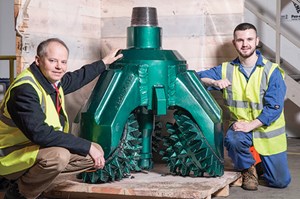
In the case study area, Eagle Ford wells typically require two to three trips for new bits, and to change out vibration-damaged BHA components. The extra trips were reducing drilling efficiency and increasing wells costs, in terms of rig-time and expenditures, for downhole motors, bits and MWD tools. In offsets, an average of 4,457.7 ft of tangent section was drilled in 29.8 hr at an ROP of 149.6 ft/hr. The curved/lateral sections averaged 6,780.6 ft and were drilled in 104.9 hr at 64.63 ft/hr. The three combined sections (11,238 ft) were drilled in an average 134.7 hr at 83.4 ft/hr, but the addition of an 18-hr round trip resulted in an overall average of 152.7 hr, reducing ROP to 73.6 ft/hr.
The updated Voyager 77/8-in., V513H PDC bit has enabled operators to drill the tangent, curve and lateral in one run. By eliminating the extra trip, and the added costs of replacing BHA components, performance has improved significantly. The first 10 bit runs with Voyager drilled all three hole sections with a single bit and BHA, averaging 12,125.4 ft drilled in 120.8 hr at an ROP of 100.38 ft/hr. In addition to achieving significant time and cost-savings, the bit has improved consistency in both drilling times and wellbore quality.
WORLD’S LARGEST DRILL BIT
An independent energy company recently completed a contract in the Danish North Sea, using what could be the world’s largest oilfield drill bit. Varel designed and manufactured a 45-in, milled-tooth bit, Fig. 7, at its Mexican manufacturing facility before shipping the 5,100-lb behemoth to Aberdeen, UK. The hybrid bit incorporates an interchangeable PDC in the center, which eliminates the need for a pilot hole, traditionally required when using a hole-opening assembly. ![]()

- Coiled tubing drilling’s role in the energy transition (March 2024)
- Digital tool kit enhances real-time decision-making to improve drilling efficiency and performance (February 2024)
- E&P outside the U.S. maintains a disciplined pace (February 2024)
- U.S. operators reduce activity as crude prices plunge (February 2024)
- Drilling advances (January 2024)
- Driving MPD adoption with performance-enhancing technologies (January 2024)
- Applying ultra-deep LWD resistivity technology successfully in a SAGD operation (May 2019)
- Adoption of wireless intelligent completions advances (May 2019)
- Majors double down as takeaway crunch eases (April 2019)
- What’s new in well logging and formation evaluation (April 2019)
- Qualification of a 20,000-psi subsea BOP: A collaborative approach (February 2019)
- ConocoPhillips’ Greg Leveille sees rapid trajectory of technical advancement continuing (February 2019)


